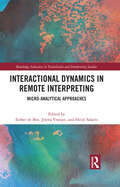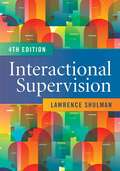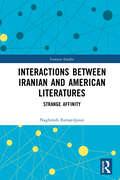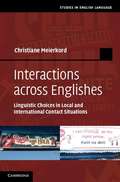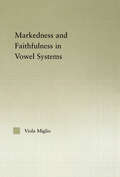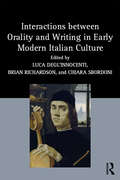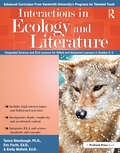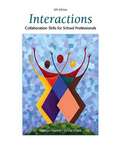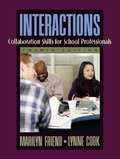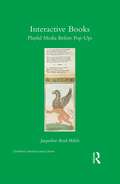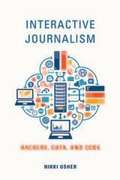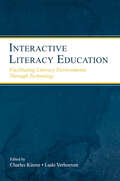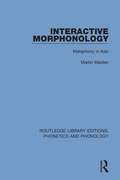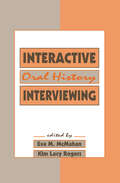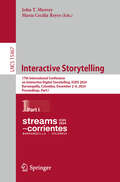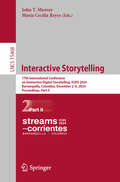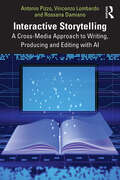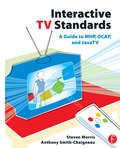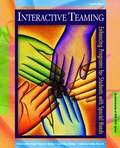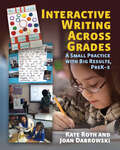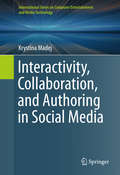- Table View
- List View
Interactional Dynamics in Remote Interpreting: Micro-analytical Approaches (Routledge Advances in Translation and Interpreting Studies)
by Esther De Boe Jelena Vranjes Heidi SalaetsThis collection introduces an innovative micro-analytical approach to interaction management in remote interpreting, offering new insights into our understanding of the conversational dynamics of remote dialogue interpreting. The book calls attention to the need for greater reflection on the impact of the increased use of remote interpreting via telephone and video link, particularly in light of the COVID-19 pandemic, on the already complex interactional dynamics of communication in dialogue interpreting settings. Featuring perspectives from both established and emerging scholars, the volume explores both the signals and mechanisms of interaction management and the effects of context in such settings. Chapters draw on empirical studies based on experimental and authentic data from video recordings and eye-tracking data to examine the impact on smoothness and synchronization of the interaction in remote interpreting, in light of the absence of multimodal resources such as gaze and gesture. In collecting this research in a single volume, the book paves the way for further research on the changing relationships between interaction management, technology, and multimodality in dialogue interpreting contexts in today’s increasingly technology-mediated world. This volume will be of interest to students and scholars in interpreting studies, language and communication, and pragmatics.
Interactional Supervision
by Lawrence ShulmanInteractional supervision models explained, applying supervision during the phases of work, education and evaluation roles of the supervisor, and working with staff groups.
Interactional Supervision
by Lawrence ShulmanClinical supervision is fraught with difficulties, and those who transition from frontline worker to supervisor often receive little training or support, particularly when it comes to the interpersonal skills needed for implementing complex human relations tasks. Left to their own devices, clinical supervisors must navigate myriad challenges like these real-world examples: <p><p>A supervisor decided that the evaluation process would be a good time to level with a long-term staff member about his inadequate performance. She reviewed the staff member s personnel record and discovered that previous supervisors had given the employee consistently positive and obviously false evaluations. She dreaded the approaching conference, expecting the worker to be angry. <p><p>A supervisor was asked by her administrator to back her up when staff were notified of budget cuts that would result in pay cuts and heavier caseloads. At a team meeting, one worker, who appeared to be speaking for the rest, said to the supervisor, You are going to be with us on this one, aren't you? <p><p>A recently promoted Black supervisor heard that many members of the largely White staff thought he had obtained the promotion because of the agency s affirmative action program. Nothing was said directly; however, he could sense tension in the staff group. He felt angry, hurt, and bitter at the racist element in his reception and increasingly isolated at the agency. <p><p>Drawing on decades of his own experience and the experiences of those he has trained, Lawrence Shulman provides clear, simple models of supervision using a conversational tone and practical advice in this must-have resource. <p><p>Every phase of supervision is discussed in detail, with a focus on communication, making demands for work, facing taboo subjects, and transitioning into and out of roles and relationships. Strategies for group work and meetings include everyday challenges; trauma, such as client deaths; violence against frontline workers; and cutbacks. Supervisors will learn how to apply Shulman s parallel process framework in their interactions with frontline workers to model ideal interactions between workers and their clients. <p><p>In this fourth edition, evidence-based practices and interventions are updated to include the latest ethical and legal aspects of supervision and also feminist; lesbian, gay, bisexual, transgender, queer, and questioning; and trauma-informed practice.
Interactions 2 Reading
by Elaine Kirn Pamela HartmannInteractions Level 2 Reading Student Book, 6th ed prepares students for college life through intensive skill development, extensive vocabulary work, and modern content. It teaches the skills and vocabulary that students need for success in university courses.
Interactions Between Iranian and American Literatures: Strange Affinity (Iranian Studies)
by Naghmeh EsmaeilpourIntroducing "narrative mobility" as a new approach in comparative studies of Iran and the US, this book reinterprets the politics and aesthetics of relations between the nations through an analysis of Iranian and American authors.The book focuses specifically on three authors—Simin Daneshvar, Shahriar Mandanipour, and Don DeLillo—who each employ narrative mobility to rethink intercultural negotiation, addressing parallel issues in America and Iran from different, but complementary, perspectives. The book analyzes the employment of parallel narrational techniques, presenting physically and virtually mobile characters who embody their respective countries as they move from one culture to another. The strange affinity between Iran and the US is ultimately revealed by viewing literary works as a "contact zone" through which the complicated relations and shared history of the two nations can be renegotiated. On a more theoretical level, the book reflects on the role of literature—in particular the novel as a transnational medium—as a bridge between nations in a period of globalization.With its focus on cross-cultural connections, the book will be of interest to anyone studying or researching comparative literature, US–Iran relations, and cultural studies generally.
Interactions across Englishes
by Christiane MeierkordEnglish is a language at the centre of research into language contact, because its global spread has resulted in contact with an enormous variety of different languages worldwide, leading to the creation of many new varieties of English, including second language varieties, and also pidgins and creoles. This book takes an original look at what happens when speakers of these different varieties interact with one another. Using her own rich fieldwork data from diverse international and South African contexts, Meierkord proposes an innovative approach to how Englishes merge and blend in such interactions, creating further new forms of English and further changes to the language. Through skilful analyses and descriptions, the book provides fascinating insights into where and who the users of English as a lingua franca are and what English then looks like at the levels of phonetics, morphosyntax, the lexicon and discourse.
Interactions between Markedness and Faithfulness Constraints in Vowel Systems: Interactions Between Markedness And Faithfulness Constraints In Vowel Systems (Outstanding Dissertations in Linguistics)
by Viola Giulia MiglioMiglio argues that to assess the relative markedness of a segment, frequency of occurrence in vowel inventories is insufficient when considered on its own. In its analysis of the Great Vowel Shift, this book elaborates a more useful model of a unitary change even in a surface-oriented theory such as optimality theory, with the help of local conjunction. Miglio extends the device of local conjunction to model opaque relations, and calls for reranking and lexicon optimization as the means to capture change within optimality theory.
Interactions between Orality and Writing in Early Modern Italian Culture
by Brian Richardson Luca Degl’Innocenti Chiara SbordoniInvestigating the interrelationships between orality and writing in elite and popular textual culture in early modern Italy, this volume shows how the spoken or sung word on the one hand, and manuscript or print on the other hand, could have interdependent or complementary roles to play in the creation and circulation of texts. The first part of the book centres on performances, ranging from realizations of written texts to improvisations or semi-improvisations that might draw on written sources and might later be committed to paper. Case studies examine the poems sung in the piazza that narrated contemporary warfare, commedia dell'arte scenarios, and the performative representation of the diverse spoken languages of Italy. <P><P> The second group of essays studies the influence of speech on the written word and reveals that, as fourteenth-century Tuscan became accepted as a literary standard, contemporary non-standard spoken languages were seen to possess an immediacy that made them an effective resource within certain kinds of written communication. The third part considers the roles of orality in the worlds of the learned and of learning. The book as a whole demonstrates that the borderline between orality and writing was highly permeable and that the culture of the period, with its continued reliance on orality alongside writing, was often hybrid in nature.
Interactions in Ecology and Literature: Integrated Science and ELA Lessons for Gifted and Advanced Learners in Grades 2-3
by Tamra Stambaugh Emily Mofield Eric FechtWinner of the 2015 NAGC Curriculum Studies Award Interactions in Ecology and Literature integrates ecology with the concept of interactions and the reading of fictional and informational texts. This unit, developed by Vanderbilt University's Programs for Talented Youth, is aligned to the Common Core State Standards for English Language Arts and Next Generation Science Standards. Students will research questions such as "Should animals be kept in zoos?" and "Should humans intervene to control overpopulation of species?" They will examine relationships among living things and the environment as well as relationships between literary elements in texts through accelerated content, engaging activities, and differentiated tasks. Ideal for gifted classrooms or gifted pull-out groups, the unit features fictional texts from Lynne Cherry, Katherine Applegate, and Jacqueline Woodson; art from Mark Rothko and Georges Seurat; informational texts about deforestation and a variety of animals; biographies about Michael Jordan, J. K. Rowling, and Walt Disney; and videos about food chains, food webs, and more. Grades 2-3
Interactions: Collaboration Skills for School Professionals
by Marilyn Friend Lynne CookTargeted at services for students with special needs, this text provides collaboration techniques between educators fraternity - special educators, general educators and related services professionals - to work towards effective communication framework.
Interactions: Collaboration Skills for School Professionals (4th Edition)
by Marilyn Friend Lynne CookInteractions, Fourth Edition, provides a cutting-edge look at how teams of school professionals-classroom teachers, special education teachers, and counselors-can effectively work together to provide a necessary range of services to students with special needs. This book addresses collaboration as a style, with accompanying knowledge and skills, which guides practices in many education efforts. As a result, future teachers learn how to collaborate with school professionals and families to help special education students who are more often being placed in general classroom settings.
Interactive Books: Playful Media before Pop-Ups (Children's Literature and Culture)
by Jacqueline Reid-WalshMovable books are an innovative area of children’s publishing. Commonly equated with spectacular pop-ups, movable books have a little-known history as interactive, narrative media. Since they are hybrid artifacts consisting of words, images and movable components, they cross the borders between story, toy, and game. Interactive Books is a historical and comparative study of early movable books in relation to the children who engage with them. Jacqueline Reid-Walsh focuses on the period movable books became connected with children from the mid-17th to the early-19th centuries. In particular, she examines turn-up books, paper doll books, and related hybrid experiments like toy theaters and paignion (or domestic play set) produced between 1650 and 1830. Despite being popular in their own time, these artifacts are little known today. This study draws attention to a gap in our knowledge of children’s print culture by showing how these artifacts are important in their own right. Reid-Walsh combines archival research with children’s literature studies, book history, and juvenilia studies. By examining commercially produced and homemade examples, she explores the interrelations among children, interactive media, and historical participatory culture. By drawing on both Enlightenment thinkers and contemporary digital media theorists Interactive Books enables us to think critically about children’s media texts paper and digital, past and present.
Interactive Journalism: Hackers, Data, and Code
by Nikki UsherInteractive journalism has transformed the newsroom. Emerging out of changes in technology, culture, and economics, this new specialty uses a visual presentation of storytelling that allows users to interact with the reporting of information. Today it stands at a nexus: part of the traditional newsroom, yet still novel enough to contribute innovative practices and thinking to the industry. Nikki Usher brings together a comprehensive portrait of nothing less than a new journalistic identity. Usher provides a comprehensive history of the impact of digital technology on reporting, photojournalism, graphics, and other disciplines that define interactive journalism. Her eyewitness study of the field's evolution and accomplishments ranges from the interactive creation of Al Jazeera English to the celebrated data desk at the Guardian to the New York Times' Pulitzer-endowed efforts in the new field. What emerges is an illuminating, richly reported portrait of the people coding a revolution that may reverse the decline and fall of traditional journalism.
Interactive Literacy Education: Facilitating Literacy Environments Through Technology
by Ludo Verhoeven Charles KinzerInteractive Literacy Education combines the latest research and theory related to technology-based instructional design for children’s literacy development. It shows how technology can be used to build literacy learning environments that are compatible with students’ cognitive and social processes. Topics addressed throughout this enlightening work include:*technology environments and applications that preservice teachers can use with young children;*detailed information regarding the development and implementation of specific technological programs; and*various technologies, from interactive reading and spelling programs to speech recognition to multimedia, that teachers can use to enhance their literacy learning environments. Interactive Literacy Education is intended for graduate courses in methods of literacy instruction; educational technology; curriculum/curriculum design; general preservice education; special education; and applied psychology/cognitive studies. It is also appropriate for use as a supplement in undergraduate courses in methods of literacy instruction and educational technology.
Interactive Morphonology: Metaphony in Italy (Routledge Library Editions: Phonetics and Phonology #16)
by Martin MaidenFirst published in 1991. The existence of morphonology had been the subject of intense debate in twentieth-century linguistic theory. Attempts to identify putatively morphonological phenomena had often foundered on the widespread assumption of a rigid dichotomy between synchronic morphological structures and the phonetic processes which historically shared them. With the difficulties of establishing any role for morphonology clearly identified, the author introduces a comparative and historical survey of the morphologization of metaphony in Italian dialects. On the basis of this the existence is argued of authentic synchronic ‘morphonological’ interaction between morphological structures and phonetic processes, such that inflectional paradigms serve to specify phonetic details of implementation of incipient sound changes. The circumstances under which such interaction may be expected to occur are discussed. This book is an important contribution to our understanding of both morphology and phonology, taking seriously the implications of abandoning a rigid distinction between synchronic morphology and diachronic phonology. It successfully integrates linguistic theory with the analysis of philological data, and indicates the direction for future research on morphonology. This detailed study of Italian dialects also constitutes a valuable addition to the study of Romance dialectology.
Interactive Oral History Interviewing: Interactive Oral History Interviewing (Routledge Communication Series)
by Kim Lacy Rogers Eva M. McMahanThe essays in this anthology represent, in the broadest sense, an interpretive perspective of inquiry that has flourished in oral history for the past 15 years. This perspective considers oral history interviews as subjective, socially constructed and emergent events; that is, understanding, interpretation, and meaning of lived experience are interactively constructed. The impetus for this volume was the editor's fascination with the multifaceted complexity of the oral history interview method coupled with the belief that, despite many books that address methodological issues, no single work takes as its focus those complex, interactive processes which constitute the oral history interview. The editors' purpose in developing this anthology, therefore, was to provide a variety of essays which taken together address the possibilities and constraints inherent in oral history interviewing.
Interactive Storytelling: 17th International Conference on Interactive Digital Storytelling, ICIDS 2024, Barranquilla, Colombia, December 2–6, 2024, Proceedings, Part I (Lecture Notes in Computer Science #15467)
by John T. Murray María Cecilia ReyesThis two-volume set, LNCS 15467 and LNCS 15468, constitutes the refereed proceedings of the 17th International Conference on Interactive Digital Storytelling, ICIDS 2024, held in Barranquilla, Colombia, during December 2–6, 2024. The 21 full papers, 9 short papers, and 11 Late-Breaking Works presented here, were carefully reviewed and selected from 75 submissions. The papers presented in these two volumes are organized under the following topical sections: - Part I : Theory, History and Foundations; Social and Cultural Contexts; Interactive Narrative Design; Applications and Case Studies. Part II : Virtual Worlds, Performance, Games and Play; Tools and Systems; Late Breaking Works.
Interactive Storytelling: 17th International Conference on Interactive Digital Storytelling, ICIDS 2024, Barranquilla, Colombia, December 2–6, 2024, Proceedings, Part II (Lecture Notes in Computer Science #15468)
by John T. Murray María Cecilia ReyesThis two-volume set, LNCS 15467 and LNCS 15468, constitutes the refereed proceedings of the 17th International Conference on Interactive Digital Storytelling, ICIDS 2024, held in Barranquilla, Colombia, during December 2–6, 2024. The 21 full papers, 9 short papers, and 11 Late-Breaking Works presented here, were carefully reviewed and selected from 75 submissions. The papers presented in these two volumes are organized under the following topical sections: - Part I : Theory, History and Foundations; Social and Cultural Contexts; Interactive Narrative Design; Applications and Case Studies. Part II : Virtual Worlds, Performance, Games and Play; Tools and Systems; Late Breaking Works.
Interactive Storytelling: A Cross-Media Approach to Writing, Producing and Editing with AI
by Antonio Pizzo Vincenzo Lombardo Rossana DamianoTaking a cross-media approach to the ever-changing field of digital storytelling, this book offers an essential introduction to producing and editing interactive storytelling content, and to the platforms that host it. Merging algorithmic and AI approaches with basic writing technique, the authors begin by providing a brief history of the field before moving on to practical step-by-step guides on techniques, models and software architectures. Examples and exercises are drawn from free-to-access, purpose-built software created by the authors as well as exemplary interactive storytelling work. Assuming the perspective of the storyteller and focusing on elements shared across different fields of professional communication, the book is designed to be a primer for digital communicators, irrespective of the medium they are working with. As such, the methods provided will be applicable across the spectrum of TV, film, videogames, web and mobile storytelling. Interactive Storytelling is recommended reading for professionals as well as advanced undergraduate and postgraduate students of interactive entertainment, multimedia design and production, and digital journalism.
Interactive TV Standards: A Guide to MHP, OCAP, and JavaTV
by Steven Morris Anthony Smith-ChaigneauFor any digital TV developer or manager, the maze of standards and specifications related to MHP and OCAP is daunting-you have to patch together pieces from several standards to gather all the necessary knowledge you need to compete worldwide. The standards themselves can be confusing, and contain many inconsistencies and missing pieces. Interactive TV Standards provides a guide for actually deploying these technologies for a broadcaster or product and application developer. Understanding what the APIs do is essential for your job, but understanding how the APIs work and how they relate to each other at a deeper level helps you do it better, faster and easier. Learn how to spot when something that looks like a good solution to a problem really isn't. Understand how the many standards that make up MHP fit together, and implement them effectively and quickly. Two DVB insiders teach you which elements of the standards that are needed for digital TV, highlight those elements that are not needed, and explain the special requirements that MHP places on implementations of these standards.Once you've mastered the basics, you will learn how to develop products for US, European, and Asian markets--saving time and money. By detailing how a team can develop products for both the OCAP and MHP markets, Interactive TV Standards teaches you how to to leverage your experience with one of these standards into the skills and knowledge needed to work with the critical, related standards.Does the team developing a receiver have all the knowledge they need to succeed, or have they missed important information in an apparently unrelated standard? Does an application developer really know how to write a reliable piece of software that runs on any MHP or OCAP receiver? Does the broadcaster understand the business and technical issues well enough to deploy MHP successfully, or will their project fail? Increase your chances of success the first time with Interactive TV Standards.
Interactive Tasks (The Routledge E-Modules on Contemporary Language Teaching)
by Michael Leeser Justin WhiteThis module on interactive tasks provides teachers with an overview of the nature of communication and explores the ways in which interactive tasks can promote communicative exchanges among students and teachers. The module provides guidelines for developing tasks, along with examples and options for their use in various types of language courses, including beginning level language classes, as well as more advanced language courses focusing culture, linguistics, literature, and film. Please visit the series companion website for more information: http://routledgetextbooks.com/textbooks/9781315679594/
Interactive Teaming: Enhancing Programs for Students with Special Needs (4th edition)
by Vivian Ivonne Correa Hazel Jones Carol Chase Thomas Catherine Voelker MorsinkInteractive teaming in special programs is a concept of service delivery for school-age students who are currently placed in special education programs or are at risk for referral to such programs.
Interactive Writing Across Grades: A Small Practice with Big Results
by Kate Roth Joan DabrowskiWhen done on a regular basis, interactive writing has the potential to improve independent writing. Authors Kate Roth and Joan Dabrowski detail how this systemic approach can be applied in Interactive Writing Across Grades: A Small Practice with Big Results, PreK-5.' Interactive writing harnesses the natural interactions teachers have with their students as they compose a writing piece. It allows for real-time differentiation and tailored scaffolding. This method fits within any basal writing curriculum and can be adapted to your classroom's technology levels. This book acts as a how-to guide that unpacks this powerful method, going step-by-step and grade-by-grade to figure out where and how interactive writing fits within your literacy framework. Inside you'll find:A complete overview of the interactive writing method and how it fits into your balanced literacy program Concrete ways to launch interactive writing in your classroom to support both process and craft instruction Step-by-step guidance to implement the method with students of all ages Student examples of writing from grades Pre-K through 5 to show what to expect at each phase of the process 'Listen in on a Lesson vignettes that demonstrate the type of scaffolding you can offer during interactive writing lessons Discover what makes interactive writing a particularly effective teaching practice that can support both emergent and fluent writers. Interactive Writing Across Grades can help put this method to work in the classroom immediately. '
Interactivity, Collaboration, and Authoring in Social Media
by Krystina MadejThis book includes a short history of interactive narrative and an account of a small group collaboratively authored social media narrative: Romeo and Juliet on Facebook: After Love Comes Destruction. At the forefront of narrative innovation are social media channels - speculative spaces for creating and experiencing stories that are interactive and collaborative. Media, however, is only the access point to the expressiveness of narrative content. Wikis, messaging, mash-ups, and social media (Facebook, Twitter, YouTube and others) are on a trajectory of participatory story creation that goes back many centuries. These forms offer authors ways to create narrative meaning that reflects our current media culture, as the harlequinade reflected the culture of the 18th century, and as the volvelle reflected that of the 13th century. Interactivity, Collaboration, and Authoring in Social Media first prospects the last millennium for antecedents of today's authoring practices. It does so with a view to considering how today's digital manifestations are a continuation, perhaps a reiteration, perhaps a novel pioneering, of humans' abiding interest in interactive narrative. The book then takes the reader inside the process of creating a collaborative, interactive narrative in today's social media through an authoring experience undertaken by a group of graduate students. The engaging mix of blogs, emails, personal diaries , and fabricated documents used to create the narrative demonstrates that a social media environment can facilitate a meaningful and productive collaborative authorial experience and result in an abundance of networked, personally expressive, and visually and textually referential content. The resulting narrative, After Love Comes Destruction, based in Shakespeare's Romeo and Juliet, shows how a generative narrative space evolved around the students' use of social media in ways they had not previously considered both for authoring and for delivery of their final narrative artifact.
Intercarnations: Exercises in Theological Possibility
by Catherine KellerIntercarnations is an outstanding collection of provocative, elegantly written essays—many available in print for the first time—by renowned theologian Catherine Keller.Affirmations of body, flesh, and matter pervade current theology and inevitably echo with the doctrine of the incarnation. Yet, in practice, materialism remains contested ground—between Marxist and capitalist, reductive and postmodern iterations. Current theological explorations of our material ecologies cannot elude the tug or drag of the doctrine of “the incarnation.” But what if we were to redistribute, rather than repress, that singular body? Might we free it—along with the bodies in which it is boundlessly entangled—from a troubling history of Christian exceptionalism?In these immensely significant, highly original essays, theologian Catherine Keller proposes to liberate the notion of the divine made flesh from the exclusivity of orthodox Christian theology’s Jesus of Nazareth. Throughout eleven scintillating essays, she attends to bodies diversely religious, irreligious, social, animal, female, queer, cosmopolitan, and cosmic, highlighting the intermittencies and interdependencies of intra-world relations. According to Keller, when God is cast on the waters of a polydoxical indeterminacy, s/he/it returns manifold. For the many for whom theos has become impossible, Intercarnations exercises new theological possibilities through the diffraction of contextually diverse multiplicities.A groundbreaking work that pulls together a wide range of intersecting topics and methodologies, Intercarnations enriches and challenges current theological thinking. The essays reach back into feminist, process, and postcolonial discourses, and further back into messianic and mystical potentialities. They reach out into Asian as well as inter-Abrahamic comparison and forward toward a political theology of the Earth, queerly entangling climate catastrophe in materializations resistant to every economic, social, and anthropic exceptionalism. According to Keller, Intercarnations offers itself as a transient trope for the mattering of our entangled difference, meaning to stir up practices of a better planetarity. In Intercarnations, with Catherine Keller as their erudite guide, readers gain access to new worlds of theological possibility and perception.
